Brave new world: an architecture tour of central Milan

Roula Khalaf, Editor of the FT, selects her favourite stories in this weekly newsletter.
This article is part of a guide to Milan from FT Globetrotter
Milan is not like other Italian cathedral cities. Most have a central piazza in which pretty much everything dates back half a millennium — picturesque, unchanging, creamy and sunlit. Milan, though, is grey, tough, sometimes a little ugly. A scintillating mix of the medieval and the modern, culture and commerce, its architecture is a combination of the ornate, indulgent, austere, sugary-sweet icing gothic and fascist-classical imperial nostalgia.
While the historic centres of most Italian cities have stagnated architecturally, Milan has, remarkably, continued to evolve and develop, notably in the 20th century but also in the past two decades so that it has become a palimpsest of modern, as well as more classical taste. First came industrialisation, then the desire of Mussolini’s government to rebuild the city in a grander, more ostentatiously Roman mould, then rebuilding the damage from the second world war, and later, the increasing power and wealth of the city’s fashion houses and the creep of global starchitecture: all have made their mark on a fascinating and multi-layered centro storico.
Milan has long been crowned the world’s capital of design, with its furniture and fashion houses, fairs and catwalk shows deeply embedded in its culture. It is also one of the most knowingly design-conscious places, more aware, perhaps, of the capacity of architecture and interiors to shape an urbane but rarely ostentatious everyday life. Design is not seen here only as a luxury but as something that creates a landscape of things, from café counter to dinner table, from catwalk to shop window and from the metro to the museum — a culture in which the aesthetics of objects and spaces are critical to identity and to amenity.
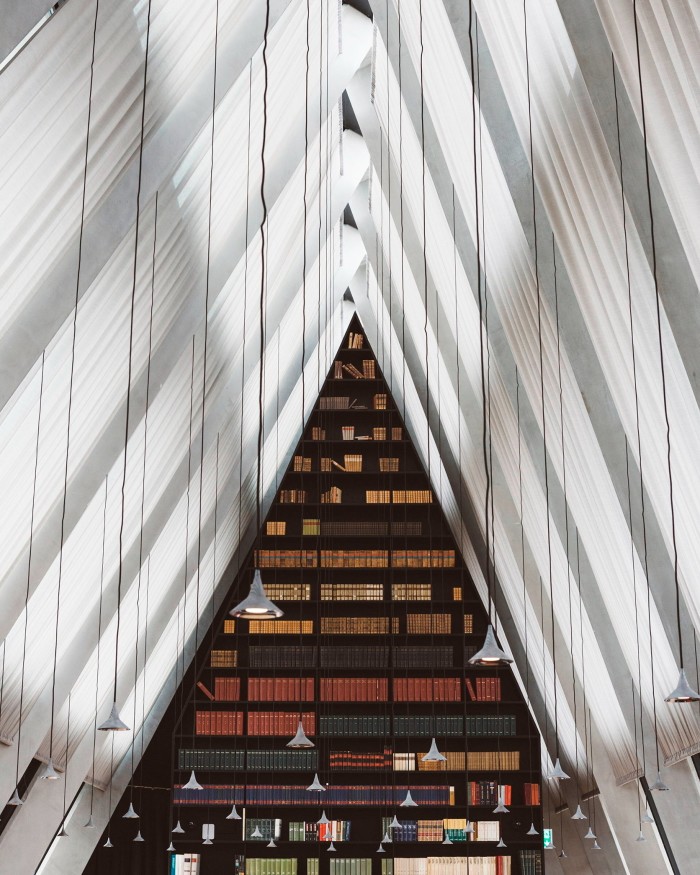
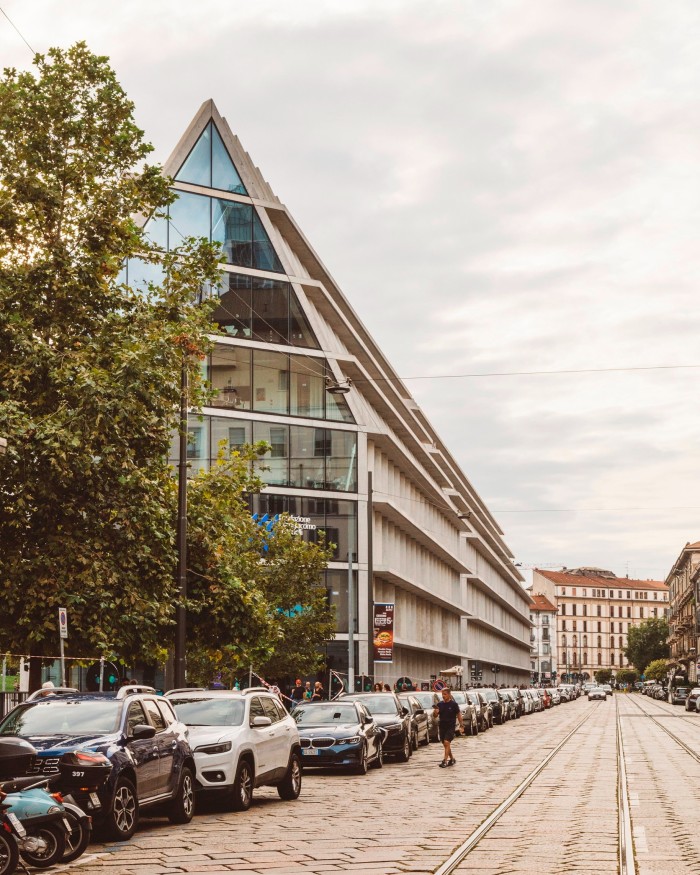
It is also a big city, the satellites of its annual Salone, the world’s premier design fair, spreading far and wide — playing their role in reinventing old industrial neighbourhoods and in the churn of change and gentrification. In the past two decades it has also become something else, a kind of contemporary architectural laboratory incubating oddly shaped towers and often rather incongruous new neighbourhoods such as Porta Nuova and the starchitect-branded CityLife. There is the much-imitated Bosco Verticale by Stefano Boeri, one of the first towers to attempt to atone for its mass by being draped in greenery, and other wacky towers by Zaha Hadid, Daniel Libeskind and Arata Isozaki. Making up for some of the city’s wrong turns are the Prada Foundation by OMA and the Feltrinelli HQ by Herzog & de Meuron, stitching the disrupted edge of the historic city back together again.
Milan’s status means that it is the kind of city where you might find yourself on a short business trip, but perhaps not so much a holiday. So there is sadly rarely enough time to take in its gems — Leonardo’s “Last Supper” and the avant garde art in the Prada Foundation — or to catch a match at the incredible San Siro Stadium, recently saved from demolition and certainly one of the world’s great football spectacles on an almost Roman scale.
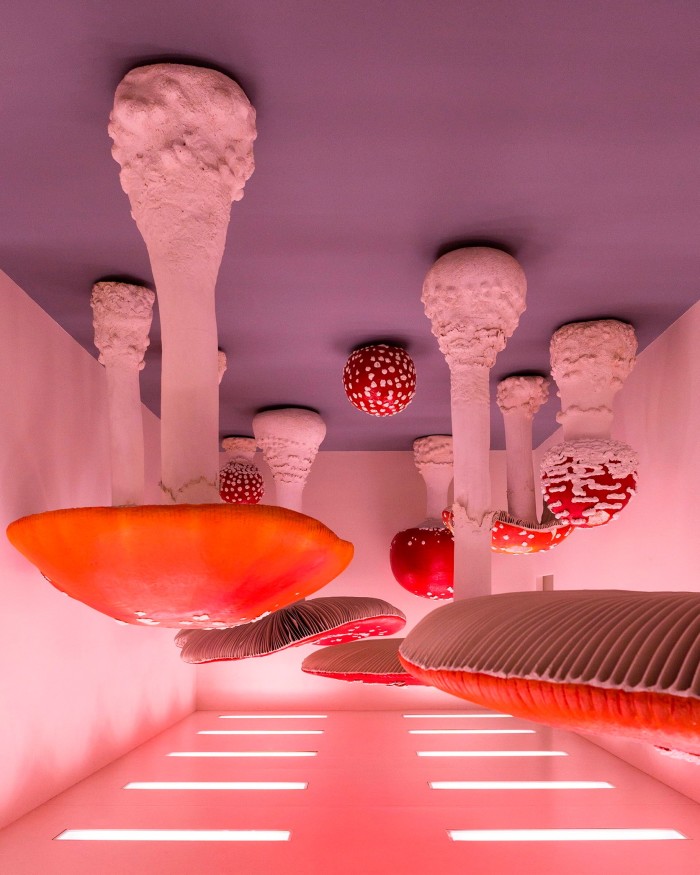
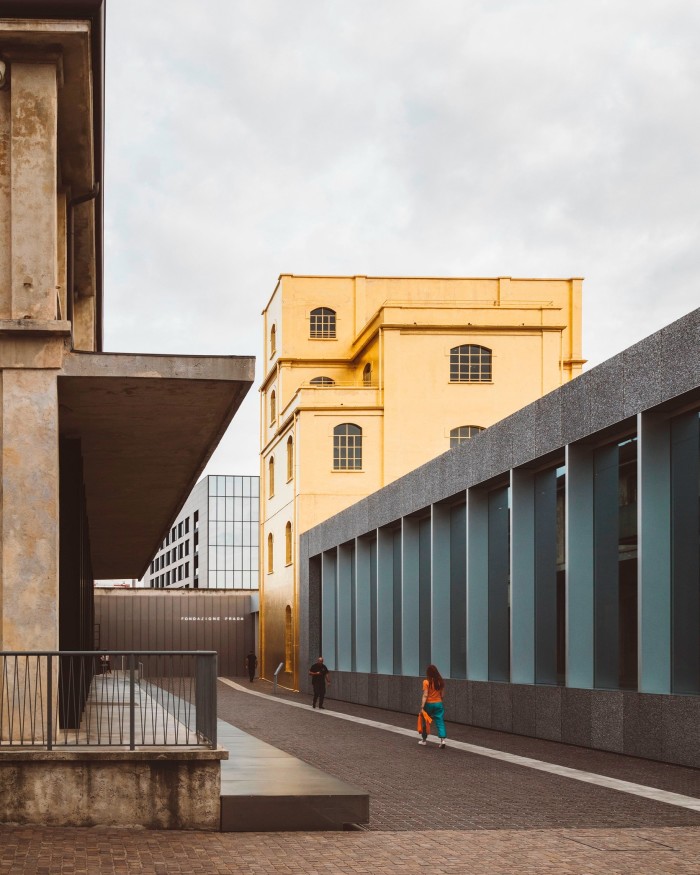
Most of us, however, at some point on our trip will find ourselves near or in Piazza del Duomo, the heaving tourist selfie-centre. So here I have outlined a rich schedule — to be dipped into at leisure — intended for the architecture-hungry but time-poor, which takes in exclusively the immediate area of the centre. Everything below is within a few blocks and perhaps a five-minute stroll of the Duomo, but it allows us to cut a cross-section through the city’s historic and modern design and to encounter some extremely fine buildings we otherwise might not notice or which would not be on a more conventional tourist agenda.
I’ve concentrated more here on the past century or so than the 20 centuries previous — Milan is, after all, a home of Modernism — but will also delve back when needed, because it is precisely this city’s mix of modes and periods, fashions and fads and the juxtaposition of old and new that makes it such a scintillating place in which to stroll for the flâneur of design.
Galleria Vittorio Emanuele II
Piazza del Duomo, 20123 Milan
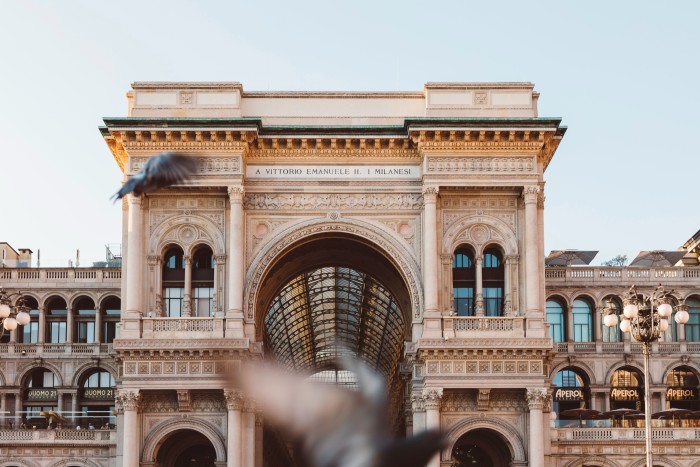
The triumphal arch-type facade that faces the Duomo looks like a deliberate reinstatement of classicism to counter all that northern gothic, but this is no Romanesque monument — rather the gateway to the world’s first shopping mall. The glass-roofed arcade was already a familiar archetype (from London and Paris) when the Galleria was opened in 1877, but Milan’s version was simply on a different scale. Designed by Giuseppe Mengoni (who died theatrically just as the arcade was completed, falling off its roof), this was a grand experience, its urbane, four-storey internal facades creating a curious confusion of street and interior, encapsulating the city, making it feel precious.
The arch acts to link the cathedral and the opera house, the city’s twin architectural poles, slicing through the historic fabric but creating a fantasia of commercial desire. A couple of decades ago, the Galleria (which, incidentally, gave its name to hundreds of rather less ambitious malls and plazas across the world) was a slightly lost place, a little unsure of itself, with its mix of second-hand bookstores and less-than-fashionable fashion stores ensuring it was rarely full, allowing the stroller to luxuriate in its scale and detail.
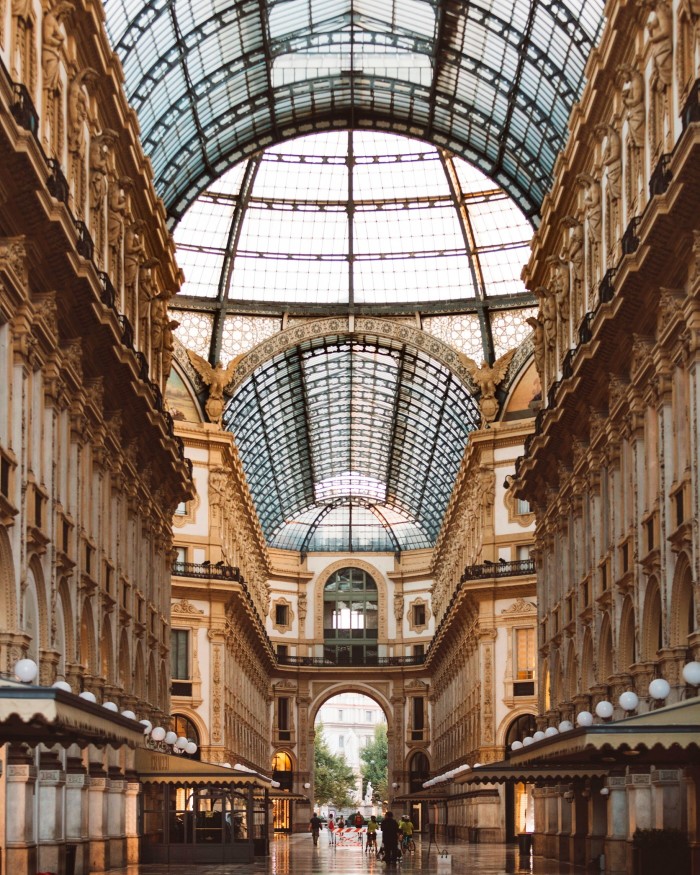
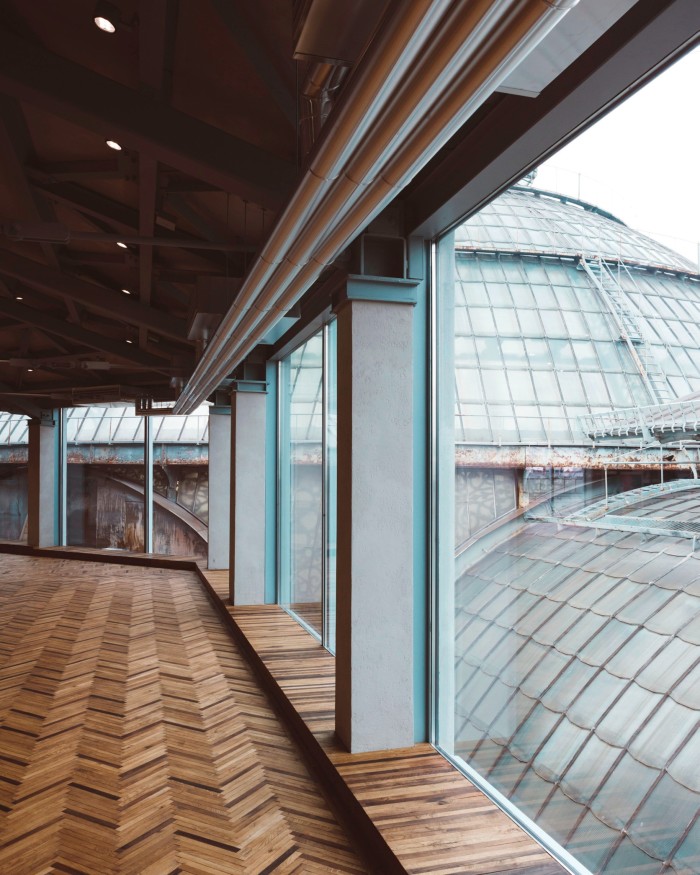
In fact, I loved it then. In recent years it has been taken upmarket, now much more dominated by global fashion brands and, notably, Prada, whose first shop in 1913 was in the arcade. It is now pretty much top of any tourist agenda, a kind of high-fashion ghetto supplemented by, rather oddly, a Burger King. It also accommodates a multistorey food mall attempting (not entirely successfully) to reconcile upscale dining and fast food. Less known is the Prada Observatory (designed by the brand’s in-house architecture team) that sits atop the structure on the level of the glass dome and which accommodates occasional, and usually superb, photography shows and gives a pigeon’s-eye view of Mengoni’s phenomenal glass roof. Website; Directions
Museo del Novecento/Palazzo dell’Arengario
piazza duomo 8, 20123 Milan
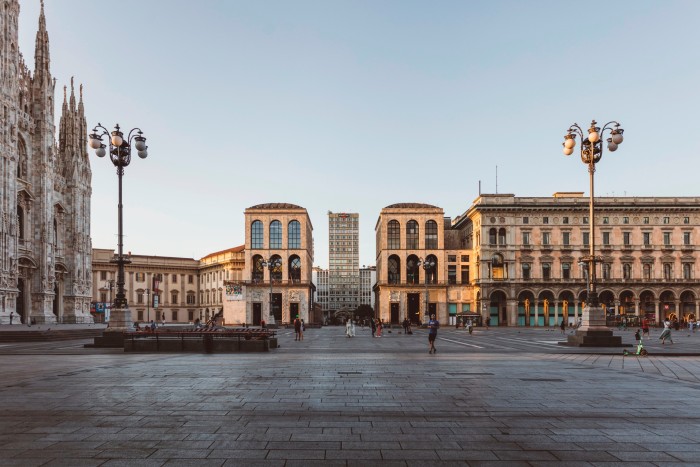
Directly opposite the Galleria is this very different gateway, a pair of buildings that act as bookends to views of the Modernist city, the 1930s extension of the centre. The result of a design competition held in 1937, these were municipal buildings through which the fascist regime aimed to stamp its identity on Milan. They display many of the characteristics of fascist architecture — the stripped classicism, the plain, de Chirico-style arches, the sculptural reliefs. Today, they look like the ghosts of Roman architecture, haunted by the past but modern in their minimal expression. They are clad in the same creamy marble as the Duomo in an attempt to integrate them with the piazza, placing fascist-era interventions in a broader historical context.
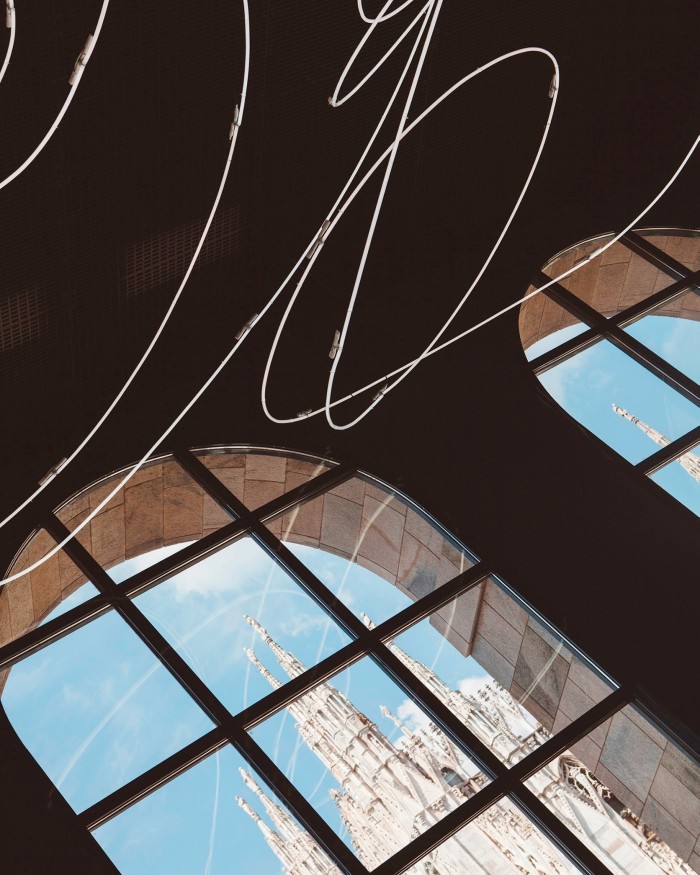
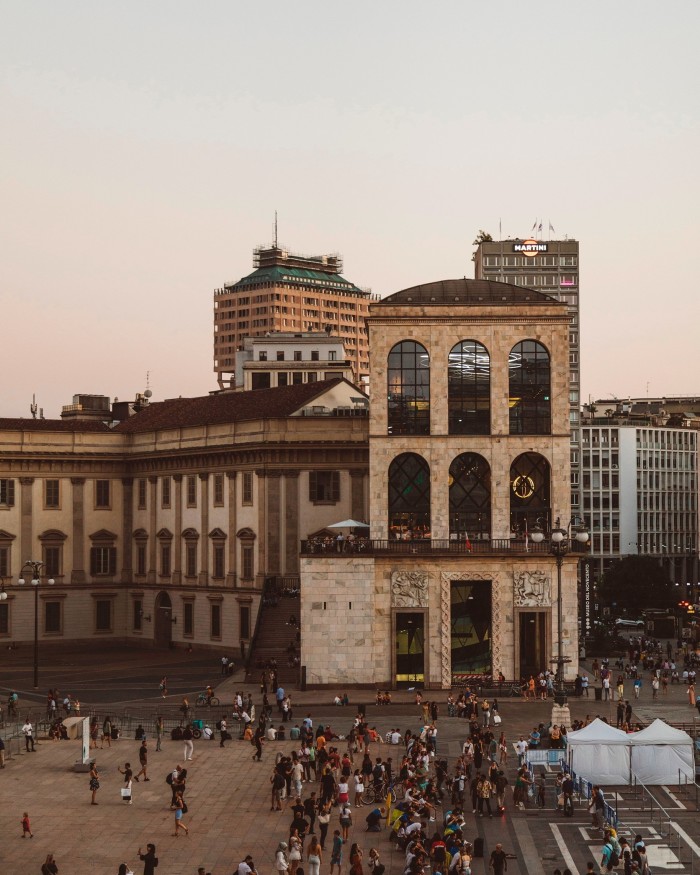
The two buildings were designed by a team of some of the greatest architects of the era — Piero Portaluppi, Giovanni Muzio, Pier Giulio Magistretti and Enrico Agostini Griffini. At the rear of the Museo del Novecento is an external stair leading to the tribune or balcony designed for Mussolini to give speeches to the assembled crowds. The new museum is the work of Italo Rota (completed in 2010), who opened up the spaces inside to create a very fine exhibition area. It is dedicated to 20th-century art and features the work of the Novecento, a movement found in Milan in 1922 in order to create an art suitable for a fascist age. The results were surprisingly varied and intense, embracing elements of Futurism, Art Deco, Surrealism and something like Socialist Realism. Well worth a visit. Website; Directions
Palazzo dell’INA
Piazza armando Diaz 6, 20123 Milan
Another fascist-era building with another triumphal arch, this big structure a few steps away from the Piazza Duomo is a fine testament to an age in design that is politically tainted but aesthetically charmed. It’s a difficult conundrum that looms over much of Milan’s modern architecture, particularly the work of Piero Portaluppi — an architect more than happy to work for the fascists, which made him deeply unfashionable for a time, but who has been recently rehabilitated as his work remains so unsettlingly stylish.
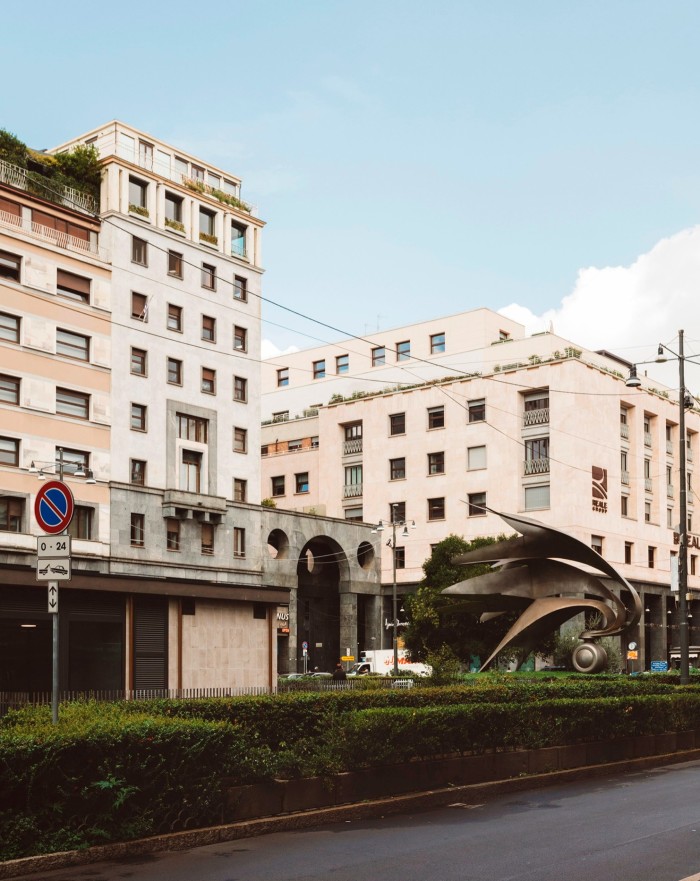
Here Portaluppi designed a major insurance building with (yet another) triumphal arch making a big urban statement and framing the view of the Chiesa Santa Maria presso San Satiro. At the base of the building, attenuated columns in the same grey granite as the arch create an arcade, and at its top a lush roof garden softens the skyline. In common with Portaluppi’s now widely fetishised apartment blocks, the architectural language of Palazzo dell’INA is restrained, hovering between tradition and modernity, with punched square windows shorn of their classical decoration but with the solidity and presence of a 19th-century edifice. The step up to the tower on the right with its loggia crown is particularly good, as is the way it meets its grey granite base and the junction with the powerfully theatrical archway. Website; Directions
At the southern end of the piazza, atop the Centro Diaz tower designed by Luigi Mattioni (1953-57), is the Terrazza Martini, one of the best places to view the illuminated Duomo and the city around it. From here you can also admire Milan’s other two Modernist towers, the sleek Pirelli Tower, designed by Gio Ponti and engineer Pier Luigi Nervi (1958) and the Velasca (BBPR, 1958), a Proto-Brutalist object that sits somewhere between a medieval castle and a hypertrophied water tower. (It’s only a short stroll to the Velasca too, if you like, though it is better from a distance than from up close — an eccentric structure out on its own in architectural history.) You can also, from here, see all the city’s subsequent towers, but none comes close to this pair of style-setters. Directions
Snia Viscosa Tower
Corso Giacomo Matteotti 11, 20121 Milan
Milan has become a city of towers in the past couple of decades, but this is the daddy — the city’s first skyscraper. A modest 15 storeys, it was designed in 1935 for the Snia Viscosa chemicals company by architect Alessandro Rimini. Another fascist-era structure, it uses similar architectural language to the Palazzo dell’INA, together with which it constitutes an urban set piece. Its slightly setback crown mediates between the modest, pared-back Milanese language and a touch of New York — it was built at the same time as the Rockefeller Center was being designed. A vertical strip of balconies gives it a little articulation and a solid base anchors it to the ground. Very fine and very refined. The tower’s architect, Rimini, was Jewish and under the racial laws of 1938 he was first stopped from practising architecture, and then imprisoned, tortured and deported. Nevertheless, he survived, outliving most of his contemporaries, dying in 1976. Website; Directions
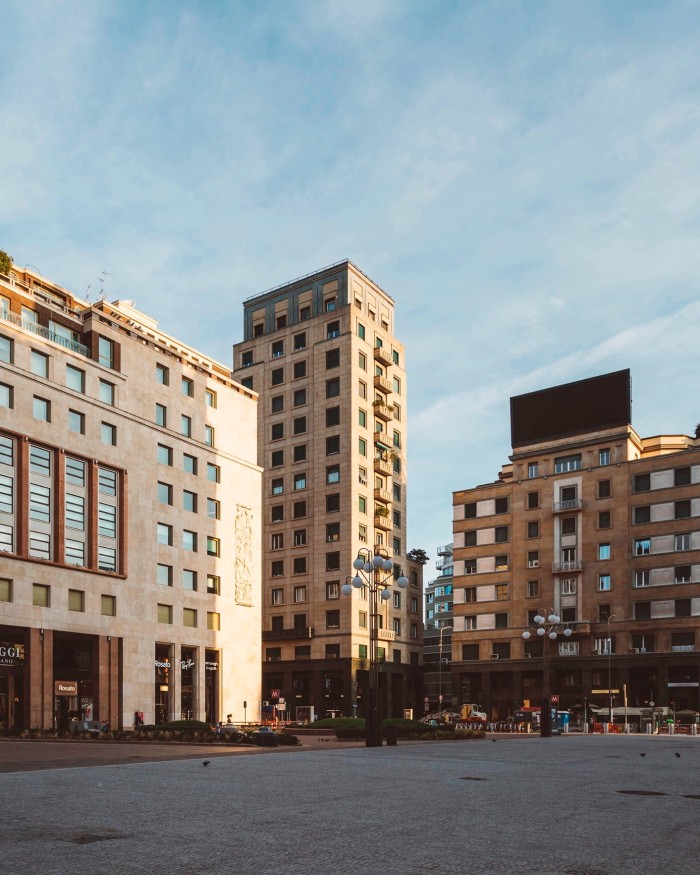
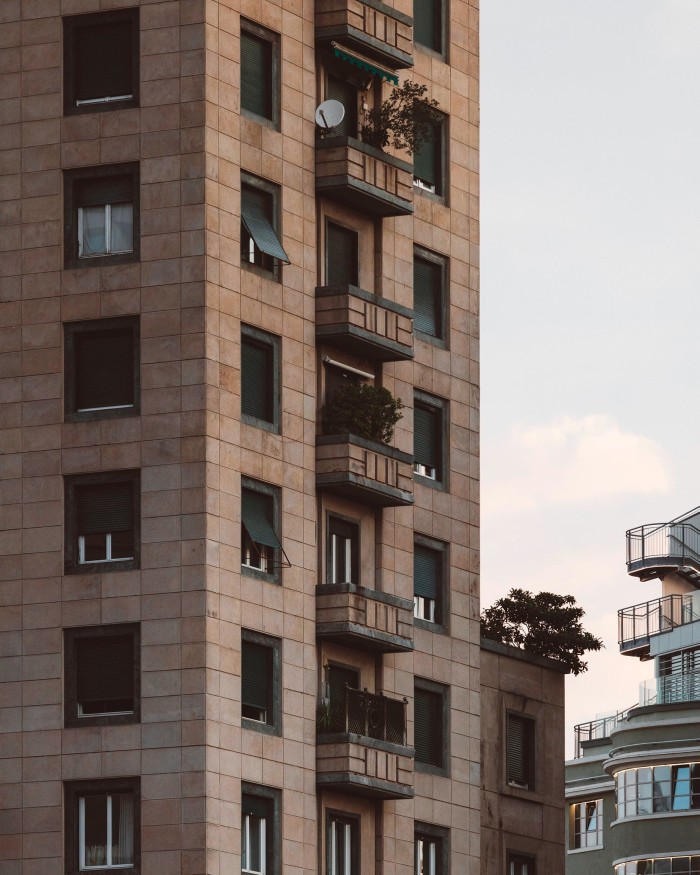
Piazza San Babila
In a nation of heart-stoppingly beautiful piazzas, it might seem a little contrarian to drag a visitor here, a short walk eastward from the Duomo. This is not a place teeming with tourists. But in its eclectic mix of architectures and periods, it presents an intriguing case study cutting through some of the city’s finest design.
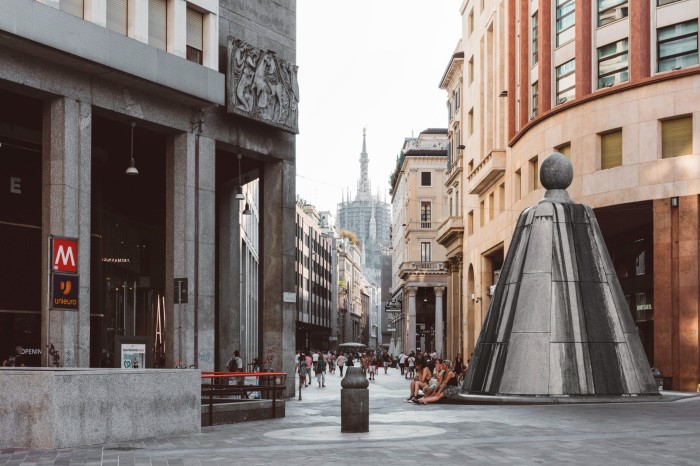
It is named after the Basilica of San Babila, a church first built in the fifth century and then rebuilt in the 11th century in a Romanesque manner with a (reconstructed) campanile. Before that, a Roman temple occupied the space. A column from the 17th century stands outside and is capped by a curious, rather older lion. The square is defined by its 1930s buildings, part of an attempt to modernise and expand the city centre. At its heart is a fountain by designer Luigi Caccia Dominioni, dating from the 1990s (the odd stone cone apparently representing the Alps, its granite fabric from the nearby foothills).
Beneath the square is the San Babila metro station, a gorgeous example of the city’s understated 1960s style. The designs for this metro were by Franco Albini and Franca Helg (for this and many other stations), with graphics by Dutchman Bob Noorda (who also designed the signage for the New York subway with Massimo Vignelli). Cool and clear, the signs are outstanding in their legibility and minimalism — but it was the mix of rubber floors (to reduce noise, now mostly replaced), concrete and marble dust panels, exquisite graphics and the accents of the bright-red handrails that come together to make this one of the world’s most refined modern underground railways.
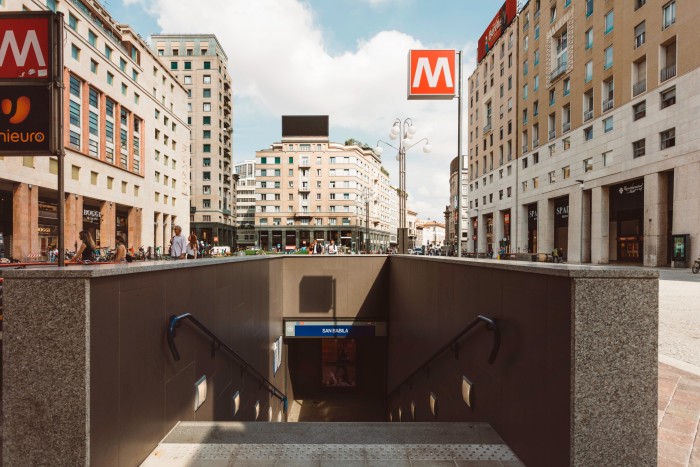
Back above ground, you might also take a look up at the Palazzo Crespi, (1928-32) on the corner of the nearby Piazza Meda and Corso Mateotti, a very good Neo-Mannerist block by Piero Portaluppi. Typically Mannered with its grey granite base and 16th-century details (broken pediments, obelisks and so on), it is an extremely fine wedge of urbanism. Nearby, the modern and contemporary-art gallery Fondazione Carriero, with interiors by Gae Aulenti (architect of the Musée d’Orsay in Paris), is exquisite. Situated in a house dating back to the 14th and 15th centuries (with a wonderfully irregular facade), it is an absolutely stunning collection of rooms, from Renaissance to Rococo, mixed with Aulenti’s cool, characterful Modernism. Check before you visit as it is only open when there is an exhibition.
Finally there is the Galleria del Corso, a slightly more restrained arcade with a brash new extension (2022) by French architect Jean Nouvel (designer of the Louvre Abu Dhabi and the Fondation Cartier in Paris). Nouvel converted a cinema into seven storeys of shopping and Blade Runner-type video screens to create a kind of multimedia shimmering blast of retail. Not subtle yet an undeniably attention-grabbing insertion. Directions
Around La Scala
Via Filodrammatici 2, 20121 Milan
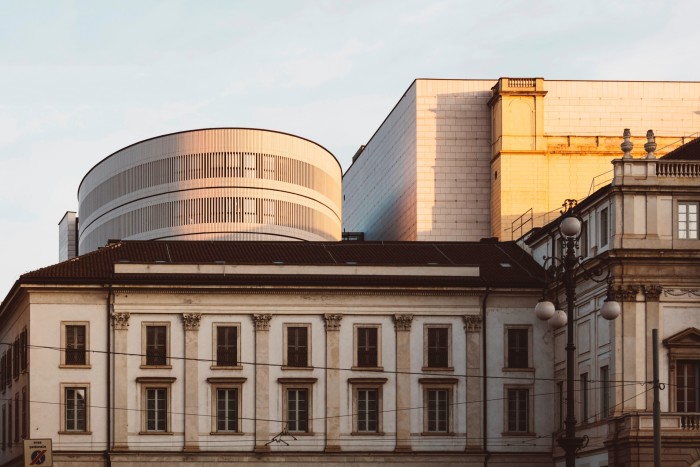
If that was too much Modernism, you might like to walk a couple of blocks north from the Piazza del Duomo (through the galleria, of course) to the Teatro alla Scala and Gallerie d’Italia museums. La Scala is the world’s most famous historic opera house, of course, a riot of red velvet and gilt in a rather restrained grey-stone case, designed by Pietro Marliani, Pietro Nosetti, and Antonio and Giuseppe Fe and completed in 1778 (after the previous theatre burnt down).
Walk around to the rear of the building and you will find Swiss architect Mario Botta’s surprisingly huge and coherent series of additions dating from the past couple of decades, the most recent instalment of which has just been completed. Just across the piazza you will also find the Gallerie d’Italia housed in the Palazzo Brentani, Palazzo Anguissola Antona Traversi and the former headquarters of the Banca Commerciale Italiana. It is a mesmerising series of interiors containing the art belonging to the city and was recently carefully restored and remodelled by architect Michele di Lucchi.
From here, you might like to wander over to Cova (Via Monte Napoleone 8) for an espresso and a cake in a café dating back to 1817 (it moved to its current space in 1950). Once frequented by writers, composers, opera singers and the big figures of the Risorgimento, it is now a super-luxe pasticceria. Much restored, it retains some of its civilised atmosphere, if not much of its authenticity. And, if you have another moment, walk on to the Monumento a Sandro Pertini (a socialist former president). This squat stone cube in a small piazza is an intervention by Neo-Rationalist architect Aldo Rossi, who saw the city as a kind of stage-set for everyday life. With a fountain, steps and a viewing gallery, it forms a sort of backdrop for the city, a moment of architectural repose that allows life to go on around it. Directions
Apple Piazza Liberty and Fountain
Piazza del Liberty 1, 20121 Milan
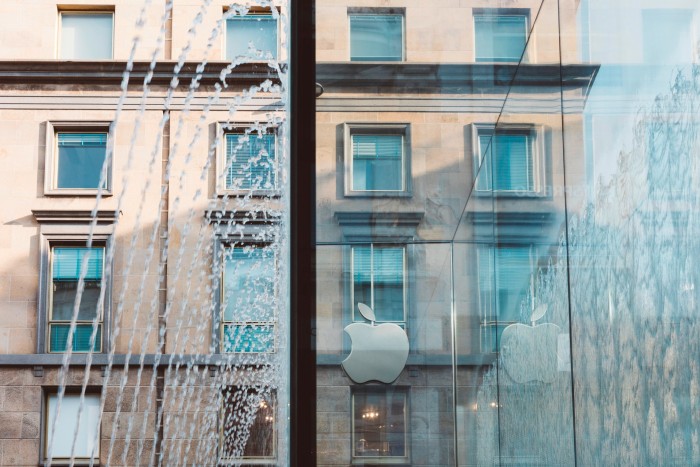
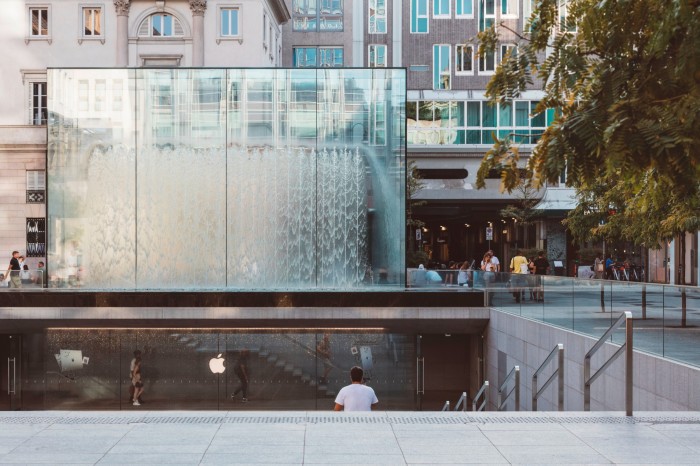
Walk back to the Duomo and veer slightly east and you’ll come across another recent addition to Milan’s cityscape, a characteristically minimal Apple store in the Piazza Liberty. Designed by Foster + Partners, it has been buried underground with a broad set of theatrical steps leading down to it (very useful indeed for pizza-slice-eating tourists). Above ground it is manifested only by a glass-walled fountain, perhaps an illusion to the confusion between the iPhone screen and reality. It also works as a lantern for the store below (which actually occupies the space of a former cinema). The structure is a reflection on the city’s archaeology, its layering and, perhaps, as a little tribute to its Modernist metro system — Foster, having designed the Bilbao metro and the incredible Canary Wharf station in London, is a connoisseur of subterranean transport. Website; Directions
Edwin Heathcote is the FT’s architecture and design critic
Tell us about your favourite building in Milan in the comments below. And follow FT Globetrotter on Instagram at @FTGlobetrotter
Cities with the FT

FT Globetrotter, our insider guides to some of the world’s greatest cities, offers expert advice on eating and drinking, exercise, art and culture — and much more
Find us in Milan, London, Tokyo, New York, Paris, Rome, Frankfurt, Singapore, Hong Kong, Miami, Toronto, Madrid, Melbourne, Copenhagen and Zürich

Comments